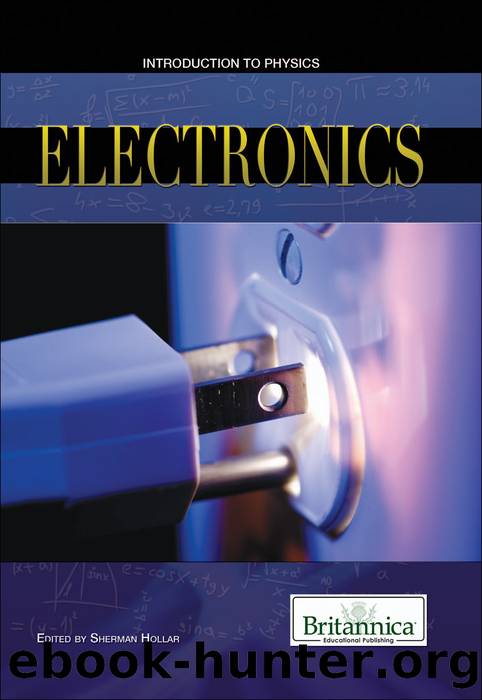Electronics by Britannica Educational Publishing

Author:Britannica Educational Publishing
Language: eng
Format: epub
Publisher: Britannica Educational Publishing
Published: 2012-10-15T00:00:00+00:00
An integrated circuit, or microchip, is made in a sequence of operations. (One type, called an n-channel metal-oxide semiconductor transistor, requires about a dozen steps.) First, a clean p-type silicon wafer is oxidized to produce a thin layer of silicon dioxide and is coated with a radiation-sensitive film called a resist (a). The wafer is masked by lithography to expose it selectively to ultraviolet light, which causes the resist to become soluble (b). Light-exposed areas are dissolved, exposing parts of the silicon dioxide layer, which are removed by an etching process (c). The remaining resist material is removed in a liquid bath. The areas of silicon exposed by the etching process are changed from p-type (pink) to n-type (yellow) by exposure to either arsenic or phosphorus vapor at high temperatures (d). Areas covered by silicon dioxide remain p-type. The silicon dioxide is removed (e), and the wafer is oxidized again (f). An opening is etched down to the p-type silicon using a reverse mask with the lithography/etching process (g). Another oxidation cycle forms a thin layer of silicon dioxide on the p-type region of the wafer (h). Windows are etched in the n-type silicon areas in preparation for metal deposits (i). Copyright Encyclopædia Britannica, Inc.; rendering for this edition by Rosen Educational Services
Download
This site does not store any files on its server. We only index and link to content provided by other sites. Please contact the content providers to delete copyright contents if any and email us, we'll remove relevant links or contents immediately.
Goodbye Paradise(3729)
The 101 Dalmatians by Dodie Smith(3454)
Flowers For Algernon by Daniel Keyes(3021)
Sapiens and Homo Deus by Yuval Noah Harari(2987)
Winnie_The_Pooh by A. A. Milne(2985)
Finding Gobi by Dion Leonard(2783)
Wait for You by J. Lynn(2741)
Remember It! by Nelson Dellis(2709)
Grumpy Cat by Grumpy Cat(2691)
Draw-A-Saurus by James Silvani(2656)
The Meaning of the Library by unknow(2506)
Harry.Hole.01.The.Bat.1997 by Nesbo Jo(2321)
Warriors by Erin Hunter(2294)
Tippi by Tippi Hedren(2186)
Frankly, Frannie by AJ Stern(2169)
See You in the Cosmos by Jack Cheng(2159)
Chronicles of Ancient Darkness by Michelle Paver(2098)
The Peter Rabbit Stories by Potter Beatrix(2089)
Practical Magic by Alice Hoffman(2062)
